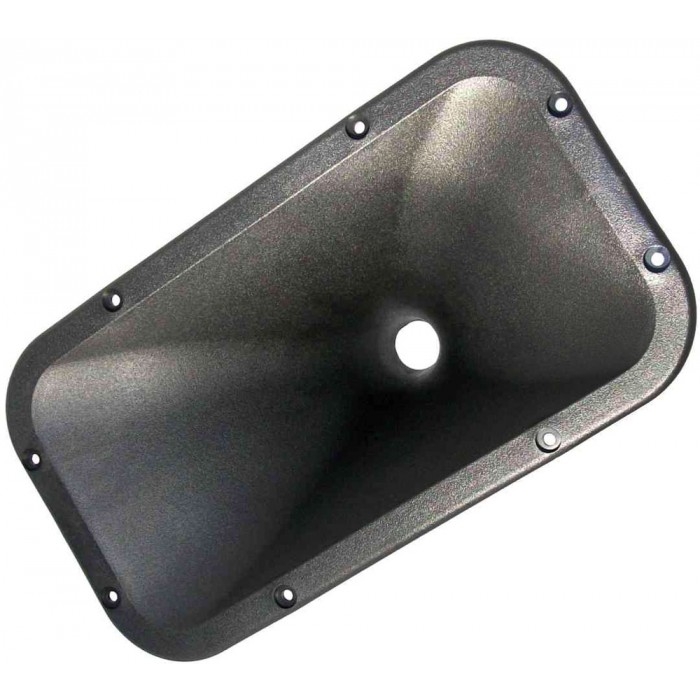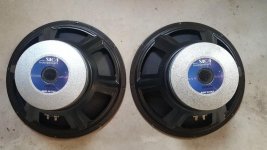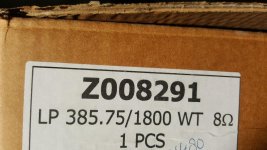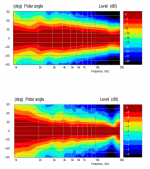This one, it's expensive for a pressed steel chassis, largely due to the neo magnet. The Germans love it.
It's not optimal, but at least close to your target of 100dB.
Here's the driver in a 25L and a 30L CB:
It looks good on the paper but the measurement protocol is not specified and have an huge impact on the sensitivity results.
It's a sim, so no guarantees. Since you are French, you're probably aware of this site, that I consider one of the best online simulators.
The input data is wrong.
Yes, the measured T&S differs a lot from the manufacturer ones and the effciency is around 97-98Db, it starts to decline rapidly under 200Hz.
Sorry i'm too lazy to do the maths, but the efficiency is physically limited with 25 liters, this driver will not go higher.
This unit looks like a rebranded celestion.
Yes, the measured T&S differs a lot from the manufacturer ones and the effciency is around 97-98Db, it starts to decline rapidly under 200Hz.
Sorry i'm too lazy to do the maths, but the efficiency is physically limited with 25 liters, this driver will not go higher.
This unit looks like a rebranded celestion.
That's not far from the truth. Celestion and IMG Stageline/Monacor are brands from the same holding company.
Aside from very few exotic exceptions, most larger cones will be physically limited with 25L.
If I got it right - low-mids from a large, light cone with a rather big horn + seperate subs - I appreciate what you're aiming for, even though it might not be my personal preference.
Ideally, you should calculate backwards. Start with the enclosure + damping and derive the optimal parameters. This will require quite a bit of work, but would make the quest for an appropriate driver easier.
Last edited:
That's not far from the truth. Celestion and IMG Stageline/Monacor are brands from the same holding company.
Aside from very few exotic exceptions, most larger cones will be physically limited with 25L.
If I got it right - low-mids from a large, light cone with a rather big horn + seperate subs - I appreciate what you're aiming for, even though it might not be my personal preference.
My preference goes for the highest level of intelligibility with the lowest level of acoustical energy. therfore a low NF, a high impedance coupling and the fewest reflexions as possible seems to be a rational POV.
A radial horn will spread too much of the acoustical energy on the sides and therfore reducing the intelligibilty because of the reflexions and also reduce the efficiency at the listenig point, so i've left the idea of a radial horn and focused on the expertise of Europeean PA manufactuers... and finally find a compromised CD horn that feeds my needs mutch better.
I wouldn't not be disagreable with monacor but it is not a bad thing to use the celestion brand build quality (wich is excellent, right now... today)
Some of the exotic sourced monacor units were not really impressive (i've got some uncredible photos, absolute nightmare
Seems like a sensible design philosophy 
Yes I am aware on the quality issues.
The CDX1-1747 by the way, appears to be a nice driver, based on the 1745 but with an modified suspension, which should - dependent on the horn - allow XO around 1000Hz.
I find many Celestion products eligible for domestic use.
What horn do you have in sight?
Yes I am aware on the quality issues.
The CDX1-1747 by the way, appears to be a nice driver, based on the 1745 but with an modified suspension, which should - dependent on the horn - allow XO around 1000Hz.
I find many Celestion products eligible for domestic use.
What horn do you have in sight?
Last edited:
Seems like a sensible design philosophy
Yes I am aware on the quality issues.
The CDX1-1747 by the way, appears to be a nice driver, based on the 1745 but with an modified suspension, which should - dependent on the horn - allow XO around 1000Hz.
I find many Celestion products eligible for domestic use.
What horn do you have in sight?
Sica Q07015A
I've bought some specific MDF (resin doped) with diferents colors in order to make great modular orientable enclosures.I have these as well.
Sherefore, Silverprout is working hard on the cabinets
The response graph I posted a few pages back is from a Sica 15"
You may consider this woofer, beautifully made (in Italy) with only a few parts from China:
and this Compression driver (the Poly version, though the Titanium version is cheaper and also very good):
Very high value for money, but compare prices between different shops, because they tend to vary.
You may consider this woofer, beautifully made (in Italy) with only a few parts from China:
An externally hosted image should be here but it was not working when we last tested it.
and this Compression driver (the Poly version, though the Titanium version is cheaper and also very good):
An externally hosted image should be here but it was not working when we last tested it.
Very high value for money, but compare prices between different shops, because they tend to vary.
Last edited:
I've bought some specific MDF (resin doped) with diferents colors in order to make great modular orientable enclosures.
Sherefore, Silverprout is working hard on the cabinets
Don't forget to post some pics!
I can't because it is not a radial horn !Don't forget to post some pics!
Italy :
Sica
Faital pro
B&C
18 sound
RCF
Ciare
in tutto il mondo
Yes you can!
The throat is quite smooth, similar to the QSC/PRV waveguide:

Response with the comp. driver from above:
Actually, the Italian manufacturers are:
- Faital Pro
- Sica (Jensen)
- B&C = owner of 18Sound = owner of Ciare
- RCF.
All high quality brands.
The other brand that I would immediately add to that list, as far as quality is concerned, is from Spain: Beyma.
The throat is quite smooth, similar to the QSC/PRV waveguide:

Response with the comp. driver from above:
An externally hosted image should be here but it was not working when we last tested it.
Actually, the Italian manufacturers are:
- Faital Pro
- Sica (Jensen)
- B&C = owner of 18Sound = owner of Ciare
- RCF.
All high quality brands.
The other brand that I would immediately add to that list, as far as quality is concerned, is from Spain: Beyma.
Last edited:
By definition of Dr. Geddes:
"With the “waveguide” approach, one can find that precise contour that allows the wavefront to progress to the shape that is required at the mouth to achieve the desired directivity. This is done with minimal diffraction and the resulting sound quality is distinctly improved. To me this is a waveguide – when there is a minimum of diffraction used to achieve the end result of directivity control. This can only be done through complex analysis and clearly, not every horn is a waveguide under this definition.
These days it is possible to use FEA or a large number of other techniques on devices that have varying cross sections to calculate their directivity. Doesn’t this then make them waveguides? That’s actually a good question, but has been shown to be somewhat academic."
It's deeper and its initial expansion rate at the throat is lower compared to many known waveguides, which isn't necessarily a bad thing. I skipped the SEOS for this reason. Does this make it a typical horn? I don't think so.
The polars aren't too bad and it definately doesn't sound like a typical (diffraction) horn. I think I'll customize mine somewhat by adding roundovers at the mouth. Might even make a mold from the innards with added roundovers and "press" a horntop in liquid wood.
"With the “waveguide” approach, one can find that precise contour that allows the wavefront to progress to the shape that is required at the mouth to achieve the desired directivity. This is done with minimal diffraction and the resulting sound quality is distinctly improved. To me this is a waveguide – when there is a minimum of diffraction used to achieve the end result of directivity control. This can only be done through complex analysis and clearly, not every horn is a waveguide under this definition.
These days it is possible to use FEA or a large number of other techniques on devices that have varying cross sections to calculate their directivity. Doesn’t this then make them waveguides? That’s actually a good question, but has been shown to be somewhat academic."
It's deeper and its initial expansion rate at the throat is lower compared to many known waveguides, which isn't necessarily a bad thing. I skipped the SEOS for this reason. Does this make it a typical horn? I don't think so.
The polars aren't too bad and it definately doesn't sound like a typical (diffraction) horn. I think I'll customize mine somewhat by adding roundovers at the mouth. Might even make a mold from the innards with added roundovers and "press" a horntop in liquid wood.
Attachments
Last edited:
- Home
- Loudspeakers
- Multi-Way
- How to Make a New Wave Biradial Horn





